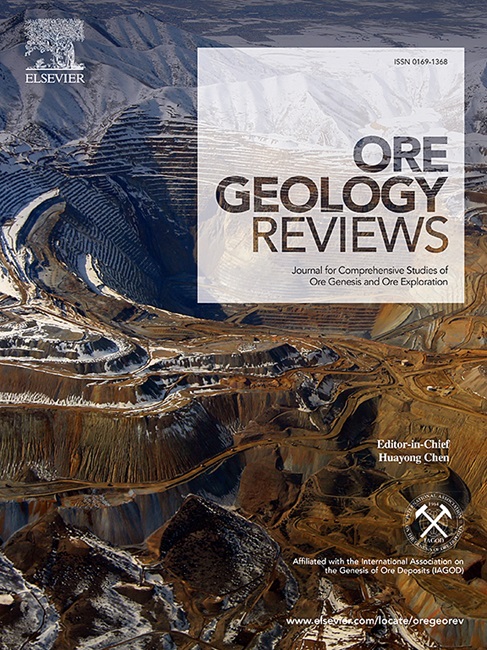基于海洋沉积物钕质量平衡模型的富铼泥形成控制因素的长期变化
IF 3.2
2区 地球科学
Q1 GEOLOGY
引用次数: 0
摘要
被称为 "富稀土泥 "的深海沉积物高度富含稀土元素(REEs),作为工业关键金属的潜在矿物资源,最近引起了人们的关注。以往对富稀土元素泥的地球化学和矿物学研究表明,沉积速率是富稀土元素泥形成的关键,因此,影响浮游沉积速率的地球系统动力学在地质时间尺度上控制着富稀土元素泥的形成、矿石品位和分布。然而,对控制富 REE 泥浆形成的环境因素及其时序变化却从未进行过系统或定量的研究。在本研究中,为了研究促进太平洋富钕铁硼泥形成的主导因素,我们构建了一个新的多箱钕(Nd)质量平衡模型,该模型考虑了海洋与海底沉积物之间的相互作用。灵敏度分析结果表明,REEs含量并不富集的风尘稀释会导致富REEs泥浆中的REEs含量降低,而REEs从大陆边缘向海洋的排放会对富REEs泥浆中的REEs含量产生强烈的积极影响。对新生代的长期模拟表明,尘埃通量主要控制着富REE泥浆中REE含量的长期趋势。计算得出的 REE 含量范围与之前报告的南北太平洋富 REE 泥浆数据中观测到的范围一致。然而,我们的模型无法再现在实际富含 REE 泥浆中观察到的 REE 浓度临时峰值。这一结果意味着,这种 REE 峰值反映了之前提出的局部或区域过程。本文章由计算机程序翻译,如有差异,请以英文原文为准。

Long-term variations of factors controlling REE-rich mud formation based on ocean–sediment Nd mass balance modeling
Deep-sea sediments highly enriched in rare-earth elements (REEs), termed “REE-rich mud,” have recently attracted attention as a potential mineral resource for industrially critical metals. Previous studies of the geochemistry and mineralogy of REE-rich mud have suggested that the sedimentation rate is key for the formation of REE-rich mud, and, therefore, that Earth system dynamics affecting pelagic sedimentation rates control the formation, ore grade, and distribution of REE-rich mud on a geological time scale. However, the environmental factors controlling the formation of REE-rich mud and their secular variations have never been studied systematically nor quantitatively. In this study, to investigate the dominant factors promoting the formation of REE-rich mud in the Pacific Ocean, we constructed a new multi-box neodymium (Nd) mass balance model that considers interactions between the ocean and seafloor sediments. Sensitivity analysis results showed that dilution by eolian dust, which is not enriched in REEs, results in decreased REE contents in REE-rich mud, whereas the discharge of REEs from the continental margin to the ocean can have a strong positive impact on the REE content of REE-rich mud. Long-term simulations through the Cenozoic demonstrated that dust fluxes dominantly control the secular trend of REE contents in REE-rich mud. The calculated REE content range is consistent with the range observed in data previously reported for North and South Pacific REE-rich mud. However, our model could not reproduce the temporary peaks in REE concentrations observed in actual REE-rich muds. This result implies that such REE peaks reflect local or regional processes, as previously proposed.
求助全文
通过发布文献求助,成功后即可免费获取论文全文。
去求助
来源期刊

Ore Geology Reviews
地学-地质学
CiteScore
6.50
自引率
27.30%
发文量
546
审稿时长
22.9 weeks
期刊介绍:
Ore Geology Reviews aims to familiarize all earth scientists with recent advances in a number of interconnected disciplines related to the study of, and search for, ore deposits. The reviews range from brief to longer contributions, but the journal preferentially publishes manuscripts that fill the niche between the commonly shorter journal articles and the comprehensive book coverages, and thus has a special appeal to many authors and readers.
 求助内容:
求助内容: 应助结果提醒方式:
应助结果提醒方式:


